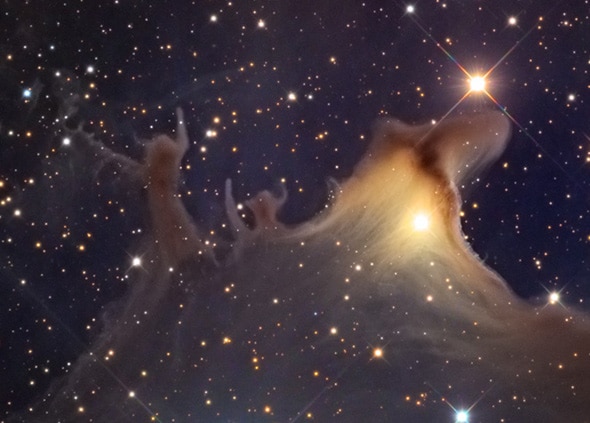Create a free profile to get unlimited access to exclusive videos, sweepstakes, and more!
The Ghosts of Distant Stars. Literally. Well, Figuratively.

We are a reflection of the Universe, in that weâre part of it. But the Universe is also a reflection of us, in that we read our own experiences into it.
One of the strongest of those forces is pareidolia; seeing faces or other familiar forms in unassociated patterns. You might see faces in clouds, and shapes in the random speckles of a floor tile; these are the outcomes of millions of years of evolution, shaping our brains so we recognize patterns.
Iâve been posting my favorite Halloween-themed examples of this all week, and one of my all-time picks is of the nebula called Sharpless 2-136, also known as the Ghost Nebula. Why? Because this:
I mean, seriously. This picture was taken by friend-of-the-BA-blog Adam Block, using the 0.81-meter (32") Schulman telescope at Mt. Lemmon. Those two figures on the left are clearly ghosts, off to scare some poor soul out of their house and home.
OK, fine. What youâre really seeing is a thick streamer of cold, dense material, hydrogen choked withs dust. This type of cloud is called a Bok globule, after Bart Bok, who cataloged quite a few of them. These globules are only a few degrees above absolute zero, and have knots of denser material in them that can collapse to form stars. In fact, Sh2-136 has a star in the process of being born in it right now; I cut it off in the picture above, but show it here in detail.
The giveaway is the presence of the two cones opening in opposite directions. As young stars form, a disk of material swirls around them. This helps focus two jets, or beams, of matter and energy that blast out, carving tunnels through the material, and presenting themselves as those cones.
Iâm not exactly sure why, though, the thick material is forming those fingers of material sticking out that remind me so strongly of running ghosts, arms up. Itâs possible that this is not the first star formed in the globule, and that previous stars had winds and fierce ultraviolet light that blew past dense knots of material, leaving behind those long towers (much like water flowing in a creek can carve a sandbar).
I love how the light from nearby stars illuminates the otherwise dark cloud, sheets and ribbons of material glowing eerily. The colors, the shapes: Theyâre perfect for Halloween, and a fantastic example of how the forces of the Universe sculpt shapes that are further sculpted by our minds.
If the Universe indeed mirrors us, than it must be, on some level, just a little bit silly.


























